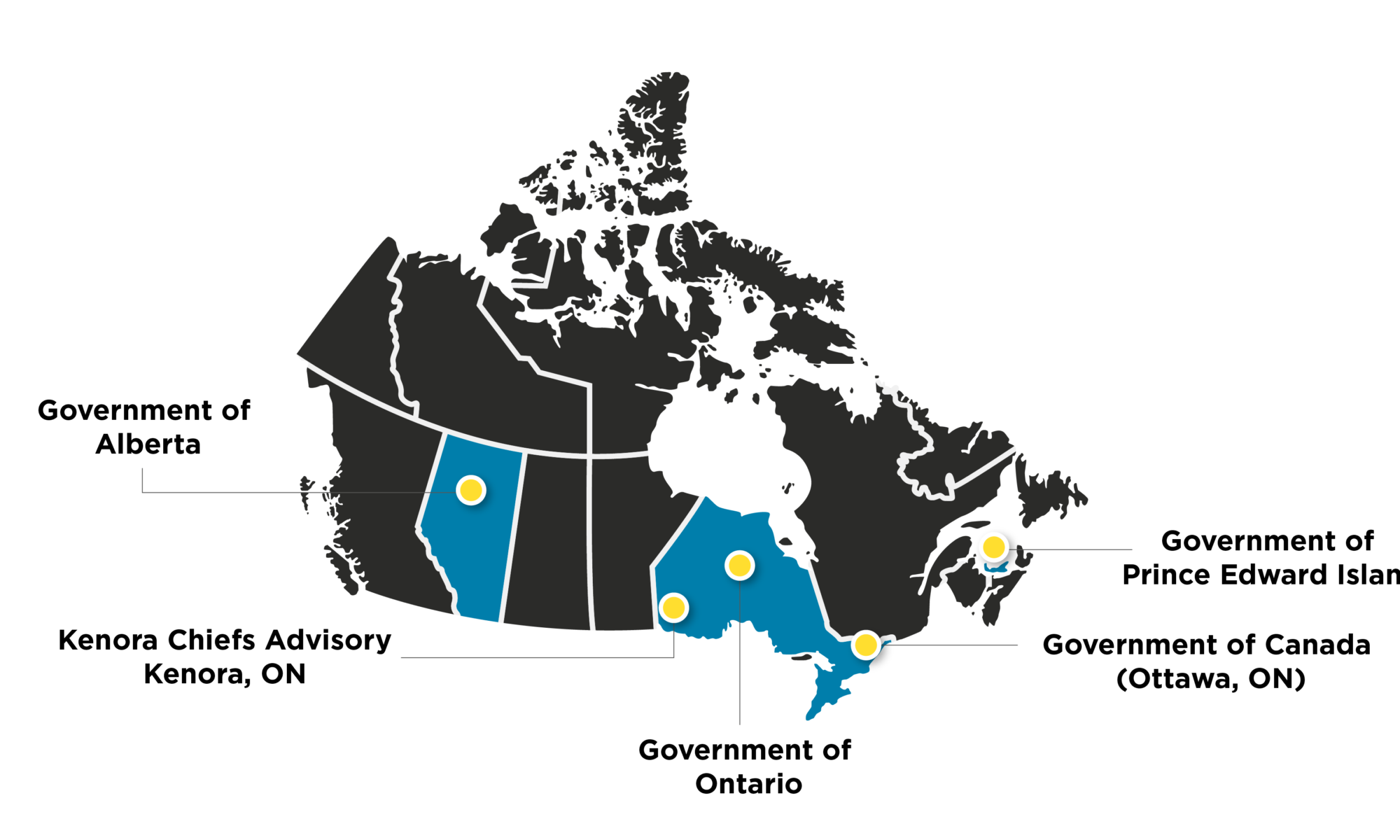
Keeping the Lights On: Did a wage subsidy in a time of crisis save Canadian businesses?
Series | Public Service Innovation and Leadership During COVID-19In mid-March 2020, Pierre Thibodeau’s thriving sports business grinded to a halt.
“The main worry was all financial.”
Thibodeau’s east-Ottawa sport equipment and apparel company, Houle Sports Excellence, was one of the thousands of non-essential businesses forced to temporarily close in a country-wide lockdown due to the COVID-19 pandemic. For two months, his 11,000 square foot storefront sat near empty. His $27,000 a month rent started to pile up. All but one of his five full-time and 10 part-time staff were laid off.
“For two months, it was just me and a bike mechanic coming in,” Thibodeau recalls. “I was basically just trying to survive.”
In his nearly 30 years in business, Thibodeau had never experienced anything like it. It was complete devastation. His laid off workers had already started collecting the Canada Emergency Response Benefit (CERB), announced at the end of March, earning them up to $2,000 a month. His business needed help too. Houle’s future was hanging by a thread.
“The big concern was there were some businesses like grocery stores and hardware stores that were open and thriving. Our concern was losing our staff to go and find a job elsewhere and then when this whole thing is over, who do we have left to work?”
While Thibodeau crunched numbers trying to keep Houle afloat, across town Maude Lavoie, the Director-General of Business Income Tax in the federal Finance Department, and her team were working hard to deliver the Canada Emergency Wage Subsidy (CEWS). The program was to be announced by Prime Minister Justin Trudeau on March 27, to provide financial support for struggling businesses.
“The government wanted it to be quick, this was an emergency environment that we were in,” Lavoie says. “With certain provincial governments asking all non-essential businesses to close, it was clear that these people and businesses were hurting. The airlines were grounded, non-essential retailers were closed and the tourism sector had no clients.”
“When millions of people are losing their jobs, the government wanted to be responsive and they wanted the money to get out as quickly as possible,” Lavoie adds.
The government had announced a temporary 10% wage subsidy at the start of the pandemic, but the goal of CEWS was to cast a wider net.
“The first wage subsidy put in place was for small businesses, but the CEWS is for all sizes of businesses,” Lavoie says, “because all businesses, no matter their size, were affected and the government felt that employees should not be penalized because they happen to work for a large employer.”
Initially the idea was to create a 75% wage subsidy for struggling employers for up to 12 weeks, retroactive to March 15, 2020. To be eligible, companies would have to have seen an at least 30% monthly drop in revenues, 15% in March. They would then be able to keep employees on payroll or rehire laid off workers. Those employees would cancel their CERB claims and instead their employer would receive the wage subsidy to continue paying staff.
Lavoie’s job under normal circumstances is to deal with business income tax. These were not normal circumstances. It was quickly realized within the government that using the already existing tax system may be the most efficient way to get the money out. Lavoie and her team would need to design the policy while at the same time another team within Finance was developing the legislation. She says in an effort to move fast, they were working in real time. Another department was responsible for putting in place the application process, payment system and controls to mitigate fraud risks. That department was the Canada Revenue Agency (CRA).
The Director General of Business Returns in the Assessment, Benefit and Service Branch with CRA, Karen Butcher, received a call on the evening of March 26, ahead of the Prime Minister’s announcement the next morning.
“We had a meeting at 10 o’clock that night and the message was, ‘the government will announce a new program tomorrow and here are the basic parameters’,” Butcher recalls. “The first thing the next morning, the team was brainstorming on how we could deliver.”
The team made decisions based on applicants’ needs. They decided that morning to eliminate paper applications, because there wasn’t enough time for them. This would be a digital program so that businesses could apply and receive the funds quickly. They wanted to use plain language to make the process as easy as possible.
“We asked the experts on processing business returns and the IT systems gurus: what do we have? What can we use or re-purpose? What is already in place that applicants will understand? How can we use it to help guide people?”
From the beginning, Butcher says, there were obstacles and tough questions.
“Our biggest concern was the need to implement quickly,” she says. “How fast can we launch a new program in order to get money flowing? How can we ensure applicants are eligible and the information provided is correct? Most importantly, how could we get the money out quickly so businesses keep their employees on their payroll, so people can buy groceries and pay their rent or their mortgage?”
Butcher and her team decided to base the CEWS application on the payroll system they already had, which offered company employment history. They believed using existing systems and account information would help to mitigate fraud risks.
Butcher explains the existing systems would give them a number of validities, or fraud prevention measures, upfront.
“This assures applicants are legitimate. For example, a business can’t suddenly say ‘we have 400 employees’ and our records show remittances for 20 employees. We can follow up and ask, how do you suddenly have 400 employees?’
“Our systems are able to verify information provided in the application, flag for manual review, and then it’s a matter of checking with the applicant to ensure that yes their claim is correct,” Butcher adds.
This was key. While it was difficult to predict the extent of the crisis, the Department of Finance originally estimated that the first three months of the program could cost more than $70 billion. Billions of Canadian dollars were at risk.
CRA had already rolled out CERB, so they had some experience in this crisis. Butcher says there were lessons that they brought with them.
“CERB had to be stood up from scratch rapidly. The priority was to get money to people in need quickly and so they didn’t have the luxury of implementing as many upfront validities. Businesses are identified across the country by a business number, so we said, ‘how can we use information on file to help us make the process secure and make sure we’re keeping out fraudsters?’”
Teams across the CRA rallied. Butcher recalls Webex calls with 1,500 people, where CRA spokespeople explained the program and answered questions educating organizations and listening to feedback.
“There were a lot of employees from across the Agency who pulled together to make this happen,” says Butcher. “We had calls on a daily basis with hundreds of employees on the line just to make sure we were communicating as quickly and widely as possible. We had employees from across the country volunteering to help.”
When tabling legislation, the government usually works on drafts, holds stakeholder engagement and accepts comments. The process can take months, even up to a year. Not this time. Lavoie and her team were under extreme pressure, developing the legislation in just two weeks.
“It was the beginning of the pandemic, we’re at home, we have children to take care of and it was seven days a week and pretty much 24 hours a day. It was challenging for everyone.”
“From the moment this program was announced to when we started accepting application forms was exactly one month,” Butcher adds. “To stand up a program under usual circumstances would take a minimum of about 18 months.”
The legislation was complete and quickly passed. On April 27, CEWS was launched. Butcher and Lavoie considered it a success, with some minor hiccups. It was a work in progress.
“You can’t have a Cadillac when you have a month to put something in place,” Butcher admits. “We had to do a lot of communication at the start explaining to businesses that ‘yes, you will be able to make amendments to your claim but you can’t do that right now. Additional functionality is coming, and sometimes we could put in place manual workarounds to help in the interim.”
Back at Houle Sports Excellence, Pierre Thibodeau anxiously awaited application day.
“We were used to a couple of hundred customers a day in the store but now we were down to about 10 customers a day,” Thibodeau says. “We were selling less than $500 a day, which was far below normal. We easily qualified for the wage subsidy.”
Thibodeau says the application process was easy, and it took his company about five minutes to enroll. When he received confirmation that he qualified, he says, for the first time in months he felt some relief.
“The key staff members were rehired. You don’t want to lose your managers and your controllers, bike repair technicians, so we rehired our full time staff, which, with the wage subsidy, is worth it to bring them back even though we didn’t need them all. At least it ensured they wouldn’t go elsewhere.”
Businesses from across the country, from smaller to mid size companies like Houle, to large manufacturers and airlines, were accessing CEWS.
By the end of July, CEWS had paid out $24 billion, much less than the $70 billion the government estimated. It had many wondering why. Did this mean CEWS wasn’t working?
Order of Operations
“Conceptually, it’s a really good idea. In practice, though, it’s had some challenges,” says public policy expert and Public Policy Forum fellow in residence, Sean Speer.
Speer, who was a former senior economic advisor to Prime Minister Stephen Harper, says the government’s decision to roll out CERB before CEWS may have diminished the usefulness of the wage subsidy.
“When the wage subsidy was rolled out, it was after CERB. And I understand why the government prioritized CERB to try and help as many people in need as they could, but because of that sequencing, because a lot of firms let people go in that peak of the crisis and those people went on to CERB, when the details were released about how CEWS would work, a lot of people had already made those workforce decisions,” Speers says.
“I think the subsidy has worked all right, and I think conceptually the idea of trying to keep people attached to their employer in a circumstance like the one we’ve been living through makes a lot of great sense, but I think in hindsight it could have been much more effective if they would have sequenced things in such a way that the first order of business was to try and retain employees as much as possible through the wage subsidy and then followed with CERB.”
Speer says government and public servants can learn from this.
“I think the first more general lesson is: in a crisis like this, you can never err on the side of too much transparency and too much disclosure, so people and businesses can try and make the best decisions they can.”
Speer believes there is another lesson: wage subsidies can work.
“We know from a body of research that having a job is good for people. It’s good from a financial point of view but it also provides a host of non-financial benefits as well,” Speer explains. “I think it would be a huge mistake to interpret this and say that wage subsidies are ineffective or not useful. I’m a proponent of a wage subsidy, not just in a crisis but generally as a means to try and attach workers who’ve lost their job for whatever reason to employment. I think the federal government should actually think about expanding the role of wage subsidies after the pandemic.”
Since the initial launch of CEWS, the benefit has now been extended until June 2021. As of the end of November 2020, $50 billion has been accessed by Canadian companies.
Over the months, CEWS legislation has been tweaked to be more inclusive and there is no longer a minimum revenue loss requirement when applying.
Lavoie and Butcher agree: CEWS, while it had its growing pains, was a success.
“We will find out what the Auditor General says but we do think we did it well,” says Butcher. “I don’t think we would have been asked to launch the Canada Emergency Rent Subsidy (CERS) if we weren’t doing it well.”
“Now we think what could we do differently if we were building a new system to make sure in the future it is able to turn on a dime and be available for any emergency,” Butcher says.
“Everything was so quick,” Lavoie adds. “If we had more time, could we have done things better? Perhaps. Putting in place measures of this magnitude would normally take months to work out all the details. This was however a great collaborative effort and all involved showed great flexibility in a time of crisis.”
As for Thibodeau, his lesson through all of this is clear: “It shows you how vulnerable you are at any time. You never know what’s going to happen.”
“In almost 30 years in business I’ve never experienced anything like this,” he adds. “My plan is that I’m about two to three years to retirement, and that’s how much time we have left on our lease. Hopefully we can survive until then.”
For now, he’s living in the moment, day by day, month by month. There are no festivals to keep his apparel shop busy. Sports associations have all nearly shut down. Between wage and rent subsidies, he’s receiving up to $35,000 a month in help. Thibodeau says those subsidies have been his financial lifeline in a time of crisis.
“Without all these subsidies I don’t think I’d be around right now. The wage subsidy has kept us alive.”
The Government of Canada, The Wilson Foundation, The Lawson Foundation and Microsoft.








